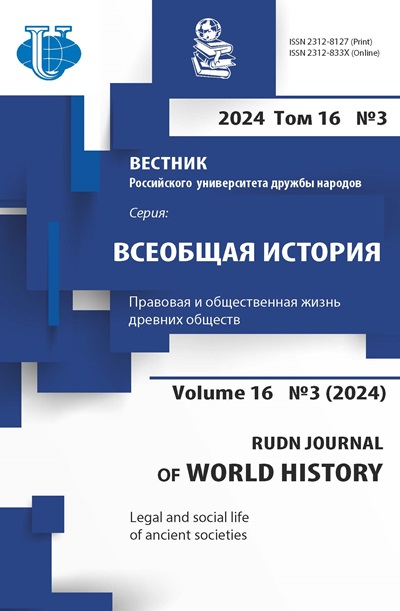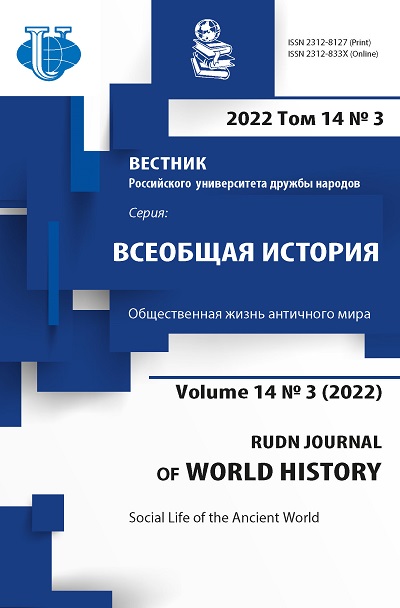Juniors age categories of athletes at the Panathenaic Games
- Authors: Gvozdeva T.B.1
-
Affiliations:
- Peoples’ Friendship University of Russia (RUDN University)
- Issue: Vol 14, No 3 (2022): Social Life of the Ancient World
- Pages: 243-256
- Section: SPORTING LIFE IN ANTIQUITY
- URL: https://journals.rudn.ru/world-history/article/view/31947
- DOI: https://doi.org/10.22363/2312-8127-2022-14-3-243-256
Cite item
Full Text
Abstract
The article is devoted to some aspects of ancient athletics of the classical period. The author traces the history of the formation of the Olympic Games program and its influence on the programs of Pan-Hellenic and local Games. The popularity of the Pan-Hellenic Games led over time to the complication of the program and an increase in the number of athletes participating in the games, for whom different age classification systems were developed. At the Olympic and Pythian Games, all athletes were divided into two age groups: paides and andres, whereas at the Isthmian and Nemean Games there were three age groups of athletes: paides, ageneioi and andres. The author explores the history of the Panathenaic Games in Athens, which are often called the “fifth” Panhellenic Games. The article shows that the program of the Panathenaic Games, on the one hand, was created on the basis of the programs of the Olympic and Pythian Games, on the other hand, it differed from it in that it included a number of competitions in which only Athenians could take part. The author shows that both the competitions “only for Athenians” and the introduction of younger age groups of athletes created more opportunities for local athletes to succeed at the Panathenaic Games and thus contributed to the development of athletics in Athens.
About the authors
Tatiana Borisovna Gvozdeva
Peoples’ Friendship University of Russia (RUDN University)
Author for correspondence.
Email: tbgvozdeva@rambler.ru
ORCID iD: 0000-0003-0400-4589
PhD in History, Associate Professor of the Department of World History, Faculty of Humanities and Social Sciences
6 Miklukho-Maklaya St, Moscow, Russia, 117198References
- Gvozdeva TB. Jerihtonij ili Tesej - kto osnoval Panafinei? [Erichthonius or Theseus, who established the Panathenaea?]. RUDN Journal of World History. 2021;13(3):259-268. (In Russ.).
- Moretti L. Olympionikai, i vincitori negli antichi agoni Olympici. Roma, 1957.
- Hönle A. Olympia in der Politik der griechischen Staatenwelt: Von 776 bis zum Ende des 5. Jahrhunderts. Bebenhausen, 1972.
- Romano DG. Athletic Festivals in the Northern Peloponnese and Central Greece. A Companion to Sport and Spectacle in Greek and Roman Antiquity. Christesen P., Kyle DG., editors. Wiley Blackwell, 2014, p. 176-191.
- Miller SG. Ancient Greek Athletics. New Haven; London, 2004.
- Shear JL. Polis and Panathenaia: the History and Development of Athena’s Festival. PhD. Ann Arbor, 2002.
- Kyle DG. Athletics in Ancient Athens. Leiden, 1987.
- Kyle DG. The Panathenaic Games: Sacred and Civil Athletics. Goddess and Polis. The Panathenaic Festival in Ancient Greece. Neils J. editor. Princeton, 1992, p. 77-101.
- Kyle DG. Sport, Society, and Politics in Athens. A Companion to Sport and Spectacle in Greek and Roman Antiquity. Christesen P., Kyle DG., editors. Wiley Blackwell, 2014, p. 159-175.
- Weir RGA. Roman Delphi and its Pythian Games. PhD. Princeton, 1998.
- Golden M. Greek Sport and Social Status. Austin, 2008.
- Gvozdeva TB. Pravo uchastija v Velikih Panafinejah [The right to participate in the Great Panathenaea]. Jekonomika, pravo, vlast’ v drevnem mire. Posvjashhaetsja pamjati V.I. Kuzishhina. St. Petersburg, 2021, p. 258-300. (In Russ.).
- Gvozdeva TB. Zhenshhiny v sportivnyh igrah Drevnej Grecii [Women in the sports games of Ancient Greece]. Sovremennyj jurist. M. 2018;3(24):114-127. (In Russ.).
- Petermandl W. Growing Up with Greek Sport: Education and Athletics. A Companion to Sport and Spectacle in Greek and Roman Antiquity. Christesen P., Kyle DG., editors. Wiley Blackwell. 2014, p. 236-245.
- Crowther NB. Athlete and State: qualifying for the Olympic Games in Ancient Greece. Journal of Sport History. 1996; 23(1):34-43.
- Golden M. Sport in the ancient world from A to Z. Lnd., N.Y., 2004.
- Golden M. Children and Childhood in Classical Athens. Baltimore, 2015.
- Golden M. Sport and Society in Ancient Greece. Cambridge, 1998.
- Petermandl W. Age-Categories in Greek Athletic Contests. Nikephoros. 2012, p. 85-93.
- Shear JL. Prizes from Athens: The List of Panathenaic Prizes and the Sacred Oil. Zeitschrift für Papyrologie und Epigraphik. 2003;(142):87-108.
- Raubitschek AE. Dedications from the Athenian Akropolis. A Catalogue of the Inscriptions of the Sixth and Fifth Centuries B.С. Cambridge, MA, 1938.
- Raubitschek AE. Leagros. Hesperia. 1939;(8):160-164.
- Kyle D. Gifts and Glory: Panathenaic and Other Greec Athletic Prieze. Worshipping Athena: Panathenaia and Parthenon. Madison, 1996, p. 106-136.
- Young DC. The Olympic Myth of Greek Amateur Athletics. Chicago: Ares, 1984.
- Ceccarelli P. La pirrica nell’antichità greco romano: Studi sulla danza armata. Roma, 1998.













